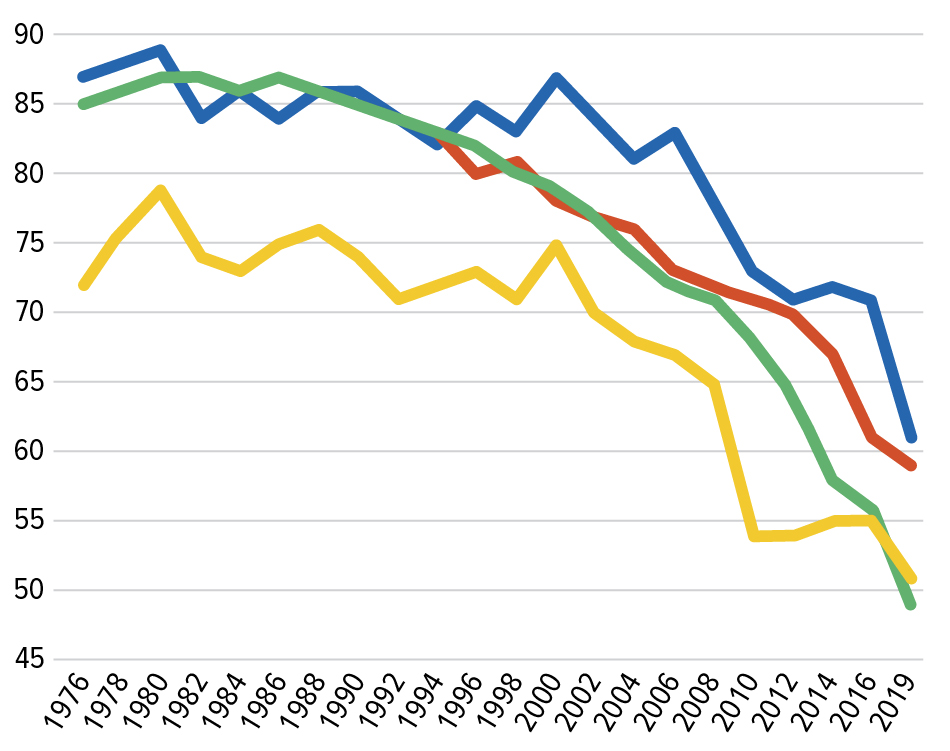
Preparing Students for Their Future, Not Our Past
AASA’s Learning 2025 initiative is showcasing student-centered, equity-focused practices through demonstration school systems
BY BILL DAGGETT/School Administrator, March 2022

|
| Bill Daggett (left), founder of the Successful Practices Network, says upgraded instructional practices, not course content, will enable schools to better prepare students. PHOTO COURTESY OF THE INTERNATIONAL CENTER FOR LEADERSHIP IN EDUCATION, REXFORD, N.Y. |
John Dewey is often quoted as saying, “We do not learn from experience. We learn from reflecting on experience.”
Everyone who is connected to schools — from teachers to board of education members — feels fatigued by the unexpected and unprecedented demands on their time and workload due to the pandemic and the overheated political debates that have engulfed the nation.
Leaders in K-12 education and policymakers have a responsibility to ask, “What have we learned? What should we continue doing, stop doing or start doing to ensure that schools are structured to prepare all students for success in a rapidly changing workplace, home and society?”
To provide school districts with the support to answer these questions, AASA convened the Learning 2025: National Commission on Student-Centered, Equity-Focused Education, which I have co-chaired with Dan Domenech, the association’s executive director.
The commission consisted of 27 commissioners, who were superintendents, corporate and foundation heads, and/or nationally respected thought leaders who recognized that shifting the nation’s education system to be more future-focused would require a methodological process. Their recommendations had to be bold and, at the same time, address the growing challenges emerging from an increasingly politically polarized climate.
The AASA commission’s report,
“An American Imperative: A New Vision of Public Schools,” can be viewed online.
The commission concluded that, to have any lasting impact, our report needed to be just the beginning of the journey of school trans-formation. That we must engage a cross-section of the nation’s school systems
to unite in a network designed to create, implement and document the most highly successful innovative practices that will (1) light the path for all other districts and (2) drive policy at the local, state and national levels.
As such, AASA, in partnership with the Successful Practices Network, created the National Network of Demonstration Systems, currently with a membership of more than 115 school districts with anticipated growth to 200 districts by the end of 2022.
A Changing Environment
As the commission reflected on the current state of education, we had to recognize that students today and the world they are preparing for are fundamentally different than what the traditional education system was designed for.
The generation of students who are graduating high school right now are the first to grow up entirely in a world where personal smart devices are ubiquitous and social media is the dominant source of information and interaction. These technologies have changed how they live and relate to each other, their parents, their communities and even their teachers.
The accompanying graph below shows a sample of the behavioral trends over time. Note the decline in the percentage of high school seniors who hold a driver’s license, tried alcohol, had a part-time job and had gone on a date before leaving high school.
Not only have kids changed in fundamental ways, but so has society in general. Artificial intelligence and other advanced digital technologies are performing tasks with increasing efficiency and accuracy as algorithms are improved upon and machines get smarter. Technological advancements continue to advance at an accelerating rate and continue to redefine the skills that will be in demand in the society and workplace of the future.
In a McKinsey & Co. study issued in February 2021 of 18,000 companies from across every industrial sector, researchers reported U.S. workers in the lowest wage quintile spent one-half of the time doing physical and manual skills. Performing physical and manual skills represented the greatest time spent in the lowest three quintiles, in fact.
 |
PERCENTAGE OF 12TH GRADERS WHO HAVE …
A drivers license
Tried alcohol
Dated
Worked for pay
SOURCE: “Monitoring the Future Study” (Twenge, fig 1.13)
|
Similarly, workers spent 18, 20 and 12 percent of the time on the job doing basic cognitive skills in the three lowest quintiles, respectively. Combined, physical/manual and basic cognitive skills accounted for only 10 percent of total time spent in the highest wage quintile.
Basic cognitive skills are those often measured by state assessments. While essential as foundational skills, they are inadequate for the demands of the best-paying jobs in most industries as well as in nearly all of our institutions, homes and communities. The question becomes “how to continue to build a strong academic foundation with basic cognitive skills, but also teach the skills that the workplace, home and society will require without adding to an already crowded curriculum?”
Future Skillsets
The answer requires identifying what those in-demand skills are and considering how to incorporate them into student learning. McKinsey & Co. has defined them in the accompanying infographic as higher cognitive skills, social and emotional skills and technological skills.
If any given skill is a task that a digital or technological device can do as well if not better than a human, an algorithm will be created to do that skill. Furthermore, machine technology is becoming increasingly capable of doing the jobs that require physical/manual skills, which will result in a significant reduction in the demand for human labor in the years ahead.
Other studies show similar shifts in the societal and workplace demands on graduates, yet educators seem to have difficulty disconnecting from the 20th-century curriculum that served them well when they were younger. Many parents of students in school today believe the traditional core curriculum is the path forward out of the pandemic as well, which creates an inertia to delivering instruction and learning that looks to the future.
Lessons Learned
School transformation is a process, not an event. District leaders need to be wary of trying to implement change too rapidly. The first step toward successful change is about messaging. Education leaders need to explain to staff, parents and community members why change is needed and assure them they will have ongoing opportunities to provide input and advice as the process moves forward.
That first step is critical because most will agree that change is needed and good until they are impacted by it. Every school district community has a unique DNA. Education systems that try to change their DNA without the general consent of the community will experience pushback. In today’s politically charged climate, the pushback from one group or another may be extreme. School leaders need to establish the
need for change as a journey that everyone is taking together. This will build a culture among staff, parents, news media and community that will support the changes required.
The universal truths that kids today are different and the workplace, home and society are changing rapidly signified a tipping point in American education. The Learning 2025 commission recognized it is not enough to be forward-focused by tinkering with the existing policies and process year after year with our budgets, curriculum, organizational structure, etc. Rather, we need to be future-focused by putting a stake in the ground for the year 2025 and figuring out what our school systems need to do to ensure we are preparing students for their future and not our past.
Learning 2025 demonstration systems understand that success is only possible when it goes no faster than the rate of readiness and trust by the staff and community. Each demonstration system knows its DNA and has its own distinctive set of implementation plans. Guided by support from a team of senior consultants who were appointed jointly by AASA and the Successful Practices Network, these districts are implementing the Learning 2025 commission recommendations that align to their specific needs and current capacity. Collectively, the network systems have incorporated all of the commission’s recommendations in their action plans.
The network systems have all committed to a common vision, which is to create an intentional, relationships-based culture among staff, parents and community that has these characteristics:
»Whole-learner focused. The entire system must attend to the social, emotional, cognitive, mental health and trauma-based needs of all learners.
»No learner marginalized. All children, families and staff must be embraced, valued equally and served with equity, regardless of race, ethnicity, religion, sexual orientation, gender, socioeconomic circumstance or disability.
»Future-driven. Schools must routinely anticipate forthcoming changes in the career, social, economic and technological landscapes to inform all decisions today.
Creative Discoveries
The network districts are moving forward with deep changes in their instructional programs that are based on growth models in cognitive, interpersonal and self-leadership skills. They are redesigning their instructional programs around the most cutting-edge research by McKinsey & Co., as well as other highly respected research groups, and around the skills, knowledge and attributes needed to be successful. It identifies the primary basic cognitive, interpersonal and self-leadership skills that serve as a foundation for future success. Those primary skill sets help to identify the secondary skill sets, which are digital, communication and technology; social and well-being; and higher cognitive.
Instructional leaders in the network districts have recognized that changes needed in instructional programs are not about content but about instructional practices — a fundamental shift in how instruction is organized and delivered where the teacher becomes more of a manager of student learning than a deliverer of instruction.
The implementation of both the cultural and instructional visions in the network districts are unlocking a wide range of resources, including technology advancements that are enabling them to personalize instruction. They have figured out how to leverage new and emerging technologies to transform their 20th-century school model, rather than forcing those technologies to conform to outdated structures and instructional practices. They also have discovered creative ways of using technology to align with a wide array of community resources.
Learning 2025 has an abundant and growing set of resources and events that can assist schools in creating a culture that embraces the new and emerging successful practices that are sprouting up across the nation. We need to bring the growing number of examples of success up to scale.
BILL DAGGETT is founder of the Successful Practices Network in Rexford, N.Y.
Additional Resources
In addition to resources on the AASA website for Learning 2025, these two opportunities provide ways to meet superintendents and share reform ideas with peers.
National Learning Summit
If you would like to see the most successful practices that have emerged from the AASA Network of Demonstration Systems, consider bringing a team to the AASA Learning 2025 National Summit, in partnership with the Successful Practices Network, to be held in Washington, D.C., June 28-30.
For more information, visit
https://spnetwork.org/events.
Demonstration Systems
To learn more about becoming a demonstration system,
click here.